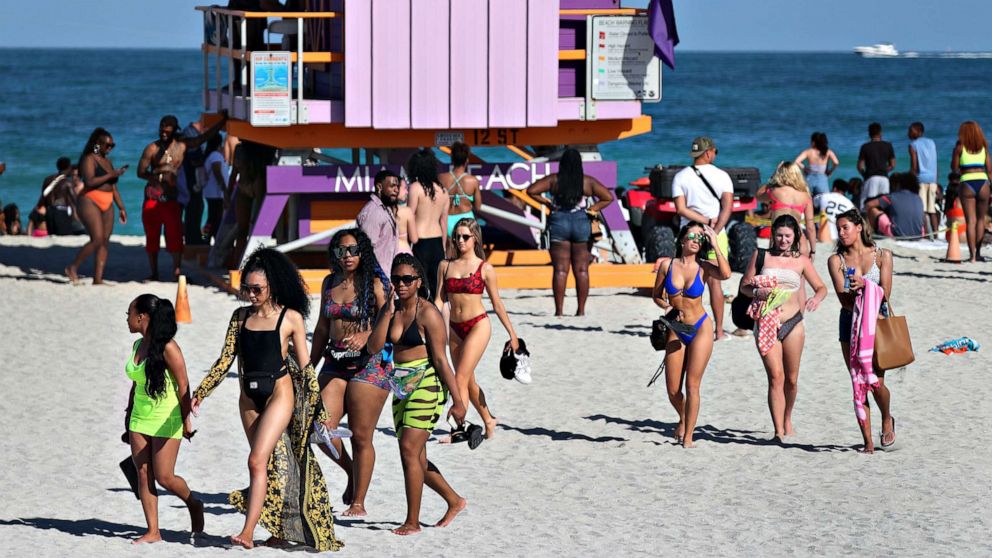[ad_1]
As colleges and universities make decisions about returning to in-person classes this fall, they may be able to keep surrounding communities safe by discouraging student travel during college breaks.
That’s the conclusion of new research that reveals what many had already suspected: Spring break travel may have fueled the spread of the coronavirus back in March, when the pandemic dramatically ramped up in the United States.
The new study out of Ball State and Vanderbilt used GPS smartphone data to track the movement of more than 7 million U.S. college students to investigate the impact of spring break travel on the spread of COVID-19.
Researchers emphasized that they used de-identified smartphone data, meaning they don’t know the names or any identifying information of anyone included in their study.
Using the data, they were able to pinpoint which cell signals seemed to go “home” to college campuses. They then tracked changes in their location during time periods known to correlate with their respective university-sanctioned spring breaks, to evaluate where students traveled and how they got there.
In the weeks following spring break, many colleges saw a rise in the number of students testing positive for the novel coronavirus. In many of these schools, the annual spring break between the end of February and early March was found to roughly precede the cancellation of classes due to the coronavirus that rolled across the country beginning in late March.
While young adults tend not to be severely affected by the novel coronavirus, experts say they may have spread the virus to other people when they returned from break, with the influx of potentially infected spring break travelers leading to an uptick in coronavirus cases in communities surrounding campus.
The highest impact seemed to come from students who traveled by plane to their destinations, especially to high-risk areas of Florida and New York.
According to Dr. Glenn Fennelly, chair of the Rutgers Department of Pediatrics, the fact that children and young adults are less likely to develop symptoms or severe complications from COVID-19 may contribute to spread within their communities.
“Many may have minimal or no symptoms and are less likely to feel ill overall,” Fennelly said. “Because of this, young people are less likely to stay at home, and are more likely to interact physically with groups of friends compared to older adults.”
“During this past spring, another alarming observation was that not all college students were following public health recommendations,” said Dr. Alok Patel, Columbia University pediatrician and ABC News medical contributor. “There were numerous reports of large parties, spring breakers not physically distancing, and many not wearing masks.”
And while deaths did not climb significantly among the college students, the counties where they live saw a rise in COVID-19 deaths approximately 4-5 weeks later — a finding that raises the possibility of a two-tier spread from college students to college students, and then to more vulnerable people in the community, such as older adults and people with underlying medical conditions.
Yet even with these alarming conclusions, researchers warn that they’re likely still underestimating the true impact spring break travel had on the pandemic.
“We are studying the impact of university students’ spring break travel on COVID-19 spread in the county of their university,” said Dr. Paul Niekamp, one of the researchers who led the study. “However, many students left their university area after the cancellation of in-person classes and returned home. Therefore, there is likely a spatial spillover effect that we are not capturing.”
Researchers behind the study see these findings as a call to action for universities, and are offering suggestions to limit the virus’ spread moving forward.
According to Niekamp, universities should consider restructuring the academic calendar to eliminate breaks when students typically travel long distances, for example by concluding in-person classes before Thanksgiving, and restricting travel for college sports.
“Universities have the power to make targeted decisions that affect the behavior of nearly 8 million undergraduates who have the potential to infect others both on campus and in surrounding communities,” Niekamp told ABC News.
Patel, meanwhile, said robust contact tracing will be essential for any university considering reopening campus this fall.
“This, undoubtedly, will be one of the most important ways to prevent campus outbreaks until we have a vaccine,” Patel said.
Jessica Johnson, M.D., is a senior resident in emergency medicine at Stanford University and contributor to the ABC News Medical Unit.
What to know about the coronavirus:
Tune into ABC at 1 p.m. ET and ABC News Live at 4 p.m. ET every weekday for special coverage of the novel coronavirus with the full ABC News team, including the latest news, context and analysis.
[ad_2]
Source link
Warning: Undefined variable $post in /var/www/wp-content/themes/newsup/inc/ansar/hooks/hook-index-main.php on line 117

